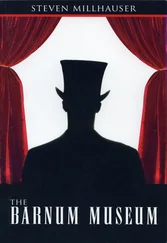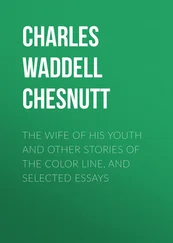As the cat hesitates, the mouse reaches into a pocket of his robe and removes a red handkerchief. With swift circular strokes he wipes out the cat’s teeth while the cat’s eyes watch in surprise. He wipes out the cat’s eyes. He wipes out the cat’s whiskers. He wipes out the cat’s head. Still held in the cat’s fist, he wipes out the entire cat, except for the paw holding him. Then, very carefully, he wipes out the paw. He drops lightly down and slaps his palms together. He looks about. He is alone with his red handkerchief in a blank white world. After a pause, he begins to wipe himself out, moving rapidly from head to toe. Now there is nothing left but the red handkerchief. The handkerchief flutters, grows larger, and suddenly splits in half. The halves become red theater curtains, which begin to close. Across the closing curtains, words write themselves in black script: THE END.
The Disappearance of Elaine Coleman
The news of the disappearance disturbed and excited us. For weeks afterward, the blurred and grainy photograph of a young woman no one seemed to know, though some of us vaguely remembered her, appeared on yellow posters displayed on the glass doors of the post office, on telephone poles, on windows of the CVS and the renovated supermarket. The small photo showed a serious face turned partly away, above a fur collar; the picture seemed to be an enlargement of a casual snapshot, perhaps originally showing a full-length view — the sort of picture, we imagined, taken carelessly by a bored relative to commemorate an occasion. For a time women were warned not to go out alone at night, while the investigation pursued its futile course. Gradually the posters became rain-wrinkled and streaked with grime, the blurred photos seemed to be fading away, and then one day they were gone, leaving behind a faint uneasiness that itself dissolved slowly in the smoke-scented autumn air.
According to the newspaper reports, the last person to see Elaine Coleman alive was a neighbor, Mrs. Mary Blessington, who greeted her on the final evening as Elaine stepped out of her car and began to walk along the path of red slates leading to the side entrance of the house on Willow Street where she rented two rooms on the second floor. Mary Blessington was raking leaves. She leaned on her rake, waved to Elaine Coleman, and remarked on the weather. She noticed nothing unusual about the quiet young woman walking at dusk toward the side door, carrying in one arm a small paper bag (probably containing the quart of milk found unopened in her refrigerator) and holding her keys in the other hand. When questioned further about Elaine Coleman’s appearance as she walked toward the house, Mary Blessington admitted that it was almost dark and that she couldn’t make her out “all that well.” The landlady, Mrs. Waters, who lived on the first floor and rented upstairs rooms to two boarders, described Elaine Coleman as a quiet person, steady, very polite. She went to bed early, never had visitors, and paid her rent unfailingly on the first of the month. She liked to stay by herself, the landlady added. On the last evening Mrs. Waters heard Elaine’s footsteps climbing the stairs as usual to her apartment on the second floor in back. The landlady did not actually see her, on that occasion. The next morning she noticed the car still parked in front, even though it was a Wednesday and Miss Coleman never missed a day of work. In the afternoon, when the mail came, Mrs. Waters decided to carry a letter upstairs to her boarder, who she assumed was sick. The door was locked. She knocked gently, then louder and louder, before opening the door with a duplicate key. She hesitated a long time before calling the police.
For days we spoke of nothing else. We read the newspapers ardently, the local Messenger and the papers from neighboring towns; we studied the posters, we memorized the facts, we interpreted the evidence, we imagined the worst.
The photograph, bad and blurry though it was, left its own sharp impression: a woman caught in the act of looking away, a woman evading scrutiny. Her blurred eyes were half closed, the turned-up collar of her jacket concealed the line of her jaw, and a crinkled strand of hair came straggling down over her cheek. She looked, though it was difficult to tell, as if she had hunched her shoulders against the cold. But what struck some of us about the photograph was what it seemed to conceal. It was as if beneath that grainy cheek, that blurred and narrow nose with the skin pulled tight across the bridge, lay some other, younger, more familiar image. Some of us recalled dimly an Elaine, an Elaine Coleman, in our high school, a young Elaine of fourteen or fifteen years ago who had been in our classes, though none of us could remember her clearly or say where she sat or what she did. I myself seemed to recall an Elaine Coleman in English class, sophomore or junior year, a quiet girl, someone I hadn’t paid much attention to. In my old yearbook I found her, Elaine Coleman. I did not recognize her face. At the same time it didn’t seem the face of a stranger. It appeared to be the missing woman on the poster, though in another key, so that you didn’t make the connection immediately. The photograph was slightly overexposed, making her seem a little washed out, a little flat — there was a bright indistinctness about her. She was neither pretty nor unpretty. Her face was half turned away, her expression serious; her hair, done up in the style of the time, showed the shine of a careful combing. She had joined no clubs, played no sports, belonged to nothing.
The only other photograph of her was a group picture of our homeroom class. She stood in the third row from the front, her body turned awkwardly to one side, her eyes lowered, her features difficult to distinguish.
In the early days of her disappearance I kept trying to remember her, the dim girl in my English class who had grown up into a blurred and grainy stranger. I seemed to see her sitting at her maplewood desk beside the radiator, looking down at a book, her arms thin and pale, her brown hair falling partly behind her shoulder and partly before, a quiet girl in a long skirt and white socks, but I could never be certain I wasn’t making her up. One night I dreamed her: a girl with black hair who looked at me gravely. I woke up oddly stirred and relieved, but as I opened my eyes I realized that the girl in my dream was Miriam Blumenthal, a witty and laughing girl with blazing black hair, who in dream-disguise had presented herself to me as the missing Elaine.
One detail that troubled us was that Elaine Coleman’s keys were discovered on the kitchen table, beside an open newspaper and a saucer. The key ring with its six keys and its silver kitten, the brown leather pocketbook containing her wallet, the fleece-lined coat on the back of a chair, all this suggested a sudden and disturbing departure, but it was the keys that attracted our particular attention, for they included the key to her apartment. We learned that the door could be locked in two ways: from the inside, by turning a knob that slid a bolt, and from the outside, with a key. If the door was locked and the key inside, then Elaine Coleman cannot have left by the door — unless there was another key. It was possible, though no one believed it, that someone with a second key had entered and left through her door, or that Elaine herself, using a second key, had left by the door and locked it from the outside. But a thorough police investigation discovered no record of a duplicate. It seemed far more likely that she had left by one of the four windows. Two were in the kitchen — living room facing the back, and two in the bedroom facing the back and side. In the bathroom there was a small fifth window, no more than twelve inches in height and width, through which it would have been impossible to enter or exit. Directly below the four main windows grew a row of hydrangea and rhododendron bushes. All four windows were closed, though not locked, and the outer storm windows were in place. It seemed necessary to imagine that Elaine Coleman had deliberately escaped through a second-floor window, fifteen feet up in the air, when she might far more easily have left by the door, or that an intruder had entered through a window and carried her off, taking care to pull both panes back into place. But the bushes, grass, and leaves below the four windows showed no trace of disturbance, nor was there any evidence in the rooms to suggest a break-in.
Читать дальше












